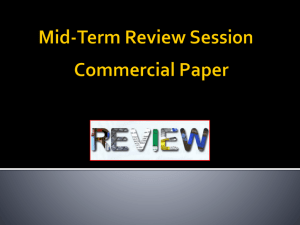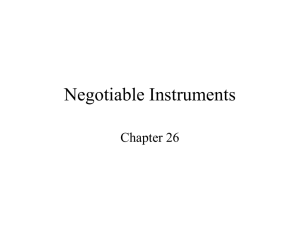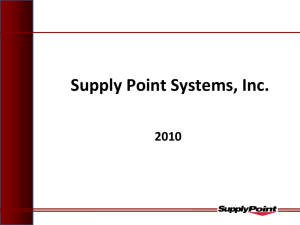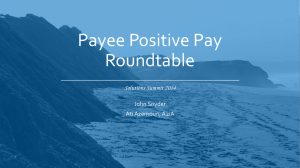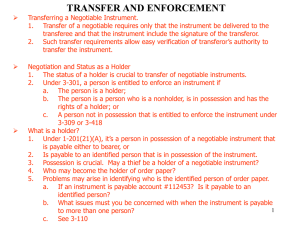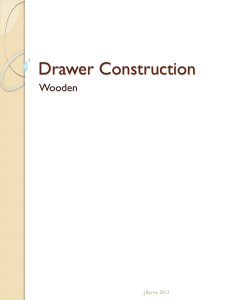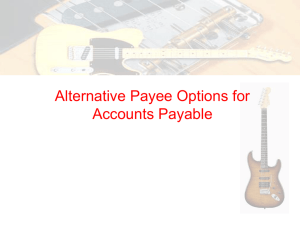PowerPoint - Professor Beyer
advertisement
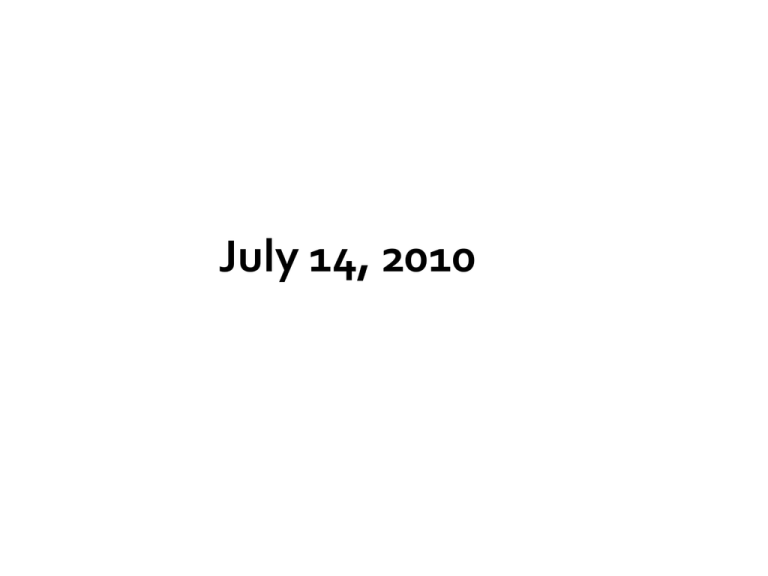
July 14, 2010 Determine whose name was forged (maker, drawer, or indorser). Different rules apply to each situation. Alleged maker not liable. Forger is liable. 1. Drawer was negligent. 2. Drawer not inspect bank statement. 2. Drawer not inspect bank statement. Duty to inspect statement and checks in a timely manner and report forgeries to bank. 2. Drawer not inspect bank statement. If not report within one year, bank does not have to recredit account even if bank negligent. 2. Drawer not inspect bank statement. “Repeat offender rule” – If the same person is forging a series of checks, the drawer must report the forgeries within 30 days. If drawer does not report, bank does not have to recredit for subsequent forgeries by the same person. 1. Recredit drawer’s account as check was not properly payable. 2. Determine if any presentment warranties breached. Normally, none will be breached. Note that the presenting party had the right to enforce the forger’s obligation and thus was a holder. 1. Bearer Paper Forgery on bearer paper is irrelevant because indorsement is not needed to negotiate. 2. Impostor Rule Issuer (maker or drawer) is estopped to deny validity of a forged indorsement if the issuer acted carelessly: ▪ Not check ID of payee. ▪ Not supervise employees (agents) who sign for the issuer. 3. Fraudulent Indorsement by Employee Entrusted with Check Payee cannot assert a forgery made by a payee’s employee entrusted with the check. 4. Failure to sue within three years Conversion liability to the payee, or Not properly payable liability to the drawer [see next slide for diagram] Bank will sue presenter and prior transferors for breach of presentment warranty of entitled to enforce (presenters and prior transferors were not holders of the check). [see diagram on next slide] Presenting bank will sue transferors for breach of transfer warranties: 1. Entitled to enforce (holder status) 2. All signatures authentic or authorized 3. No good defenses [see diagram on next slide] Obligor (maker or drawer) does not want to pay because the instrument shows a different obligation than to which the obligor originally agreed. 1. Change in obligation Amount changed – for example, $10.00 to $10,000 1. Change in obligation Date due changed – for example, August 1, 2011 to August 1, 2010. 1. Change in obligation Name of payee changed – for example, “I.N.G.” to “I.N. Garrison.” 1. Change in obligation Interest rate changed – for example, 5% to 15%. 2. Unauthorized completion Amount of check is left blank. Drawer tells payee, “fill in $50.00.” Payee says “OK.” Payee later fills in for $700.00. 1. Change in obligation = HDC can enforce for original amount. 1. Change in obligation = HDC can enforce for original amount. Maker wrote promissory note for $100. Evil payee changed to $1,000. Evil payee transfers note to HDC. HDC can enforce for $100; Maker has defense for $900 2. Unauthorized completion – HDC can enforce as completed 2. Unauthorized completion – HDC can enforce as completed Drawer signs check and says to Friend, “You can buy yourself a present with the check but no more than $100.” Friend buys present from Payee (e.g., a store) costing $500 and writes check for $500. Payee transfers check to HDC (Payee’s bank). HDC can enforce for $500. 1. Fraudulently made by holder = Total discharge of obligor 1. Fraudulently made by holder = Total discharge of obligor Maker signs promissory note payable for $100 to Payee. Payee changes amount to $1,000. Payee (not a HDC) presents to Maker. Maker is discharged (does not even owe the original $100). 2. Not fraudulently made by holder = no effect on obligation On January 2, 2011, Drawer signs check for $100 payable to Payee and writes the date as “January 2, 2010.” Payee changes the date to “January 1, 2011.” Payee may still enforce for $100. If bank pays an altered check from your account, bank must return the money to your account as the check was not properly payable ---- Unless bank has a defense. 1. Drawer was negligent. Wrote in pencil. Left blank spaces. 2. Drawer waited more than 1 year to report the alteration (drawer has duty to inspect bank statement) 1. Drawee bank sues presenter (or prior transferors) for breach of presentment warranty of no alteration. 2. Presenter sues prior transferors for breach of transfer warranty of no alteration. Routing number Account number Check number Amount Holder may discharge the obligation Cancel Destroy Return to Maker or Drawer Instrument discharges underlying obligation if it is: 1. Certified check 2. Cashier’s check 3. Teller’s check Instrument suspends underlying obligation if it is: 1. Promissory note 2. Normal (uncertified) check Instrument suspends underlying obligation if it is: 1. Promissory note 2. Normal (uncertified) check If note or check dishonored, holder may sue on either instrument or underlying obligation. A person who wants payment may not have possession: Lost the original. Original destroyed. Original stolen. To enforce the instrument, this person must prove: 1. Was holder when loss occurred. To enforce the instrument, this person must prove: 1. Was holder when loss occurred. 2. Did not voluntary transfer the instrument. To enforce the instrument, this person must prove: 1. Was holder when loss occurred. 2. Did not voluntary transfer the instrument. 3. Instrument not lawful seized. To enforce the instrument, this person must prove: 1. Was holder when loss occurred. 2. Did not voluntary transfer the instrument. 3. Instrument not lawful seized. 4. Why unable to produce the original. To enforce the instrument, this person must prove: 1. Was holder when loss occurred. 2. Did not voluntary transfer the instrument. 3. Instrument not lawful seized. 4. Why unable to produce the original. 5. Posted a security or bond to protect payor from double payment. 1. Bank may dishonor (bounce) the check. 1. Bank may dishonor (bounce) the check. 2. Bank may pay the check and seek recovery of the money from the drawer. Technically, no such thing as checks are payable on demand. Bank may pay early unless --- The customer (drawer) gives bank a notice of the postdating which describes the check with reasonable certainty. Drawer can tell drawee not to pay check. Requirements of a stop payment order: Requirements of a stop payment order: 1. In writing , but can be oral in many states but only for 14 days. Requirements of a stop payment order: 1. In writing , but can be oral in many states but only for 14 days. 2. Describe the check with reasonable certainty: ▪ Account number ▪ Check number ▪ Amount Requirements of a stop payment order: 1. In writing , but can be oral in many states but only for 14 days. 2. Describe the check with reasonable certainty. 3. Valid for 6 months unless renewed. Bank’s defense for paying check even if valid stop payment order = no loss because drawer would have to pay HDC anyway. Bank liable to customer for damages if dishonors a properly payable check unless check is more than 6 months old (a “stale” check). Bank not liable to payee for damages if dishonors a properly payable check as bank did not sign the check. Check which states that it is in full payment of an obligation that is: 1. Subject to a bona fide dispute, or 2. Unliquidated (exact amount owed not yet determined). If payee cashes the check, the check operates as an “accord and satisfaction” of the debt unless: If payee cashes the check, the check operates as an “accord and satisfaction” of the debt unless: 1. Payee returns the money within 90 days, or If payee cashes the check, the check operates as an “accord and satisfaction” of the debt unless: 1. Payee returns the money within 90 days, or 2. Payee is an organization and notified drawer of a particular person or address where payment in full checks are to be sent. Exam will be posted later today. Exam due on August 11, 2010 at 4 p.m. Exam is take home and open book. But, you cannot talk with anyone else about the exam. All questions are essay. There are 7 questions. Total of 200 points: 100 Secured Transactions 100 Commercial Paper Expected length = 2,500 to 5,000 words. Maximum length = 7,500 words. Answers should include citation to the correct section of the U.C.C. that supports your answer. You can get partial credit if you cite the correct section even if your answer is incorrect. Examination Advice: 1. Read questions carefully. Examination Advice: 2. Pay attention to exactly what the question asks. Examination Advice: 3. Organize your answers. Examination Advice: 4. Spot issues – most important Examination Advice: 5. Provide correct statement of relevant law. Examination Advice: 6. Analyze – give reasons – explain why. Any questions? gwb@professorbeyer.com Facebook Gerry W. Beyer [personal] Global Business Law LLM at La Trobe [group] Twitter – Gerry_Beyer +1-806-742-3990, extension 302
